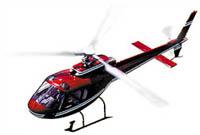Aircraft Went Down During Training Flight
 The NTSB has released a preliminary
report concerning an accident which killed two paramedics and a
commercially-rated pilot while conducting training exercises under
contract with the U.S. Army. The flight was conducted primarily to
train the pilot and one paramedic in the use of night vision
goggles (NVG).
The NTSB has released a preliminary
report concerning an accident which killed two paramedics and a
commercially-rated pilot while conducting training exercises under
contract with the U.S. Army. The flight was conducted primarily to
train the pilot and one paramedic in the use of night vision
goggles (NVG).
This is preliminary information, subject to change, and may
contain errors. Any errors in this report will be corrected when
the final report has been completed.
On February 5, 2010, approximately 1920 MST, an Aerospatiale
AS350 B2 helicopter, N157BC, was destroyed upon impact with terrain
while maneuvering in the McGregor Military Range, 23 miles
northeast of El Paso, Texas. A post-crash fire ensued. The
commercial pilot and two paramedics received fatal injuries. Night
visual meteorological conditions prevailed and no flight plan was
filed for the practice emergency medical services (EMS) flight. The
helicopter was operated by Enchantment Aviation Inc D.B.A.
Southwest Med Evac. Omniflight Helicopter Inc owned Enchantment
Aviation. The flight departed the El Paso International Airport
(KELP), El Paso, Texas approximately 1825.
The flight was conducted under an EMS contract with the United
States Army and was attempting to pick up a soldier to simulate
transporting injured Army personnel. The flight was to use night
vision goggles (NVGs) and standard company practice would be for
the pilot and paramedic seated in the left aft seat to be on
NVGs.
Several Army personnel utilizing various night vision devices
were in the vicinity of the accident. The Army personnel stated
that the helicopter arrived to the south of the accident site and
made two right turn orbits. The helicopter was seen turning on and
panning the white spot light during these orbits. Personnel on the
ground attempted to make radio contact with the helicopter but were
not successful, so they began utilizing illumination to signal the
helicopter. The helicopter was then observed to make a third orbit
which was wider than the first two. During the third orbit, the
helicopter banked approximately 45 degrees and entered a steep nose
down attitude before impacting the ground.
The helicopter collided with relatively level terrain which
contained low-lying desert vegetation and the surrounding area was
free of towers, transmission wires, and man-made obstacles. The
helicopter was found broken into several pieces, the largest of
which were found in or near the 18-inch deep impact crater. All
major components were accounted for at the accident site. The
post-impact fire consumed a majority of the cockpit
instrumentation. The forward portion of the right skid toe was
found fractured and embedded in hard soil with signatures
consistent with an impact angle of 42 degrees nose low and 35
degrees of right bank.

AS350 File Photo
After initial documentation of the scene, several components
were retained for further examination.
The commercial pilot had recently been hired by Enchantment
Aviation Inc having previously flown helicopters for the United
States Army and Maricopa County Sheriff's Office. In addition, the
pilot held airline transport pilot certificate with Boeing 737,
Boeing 757, Boeing 767, and Lockheed L-1011 type ratings. The pilot
began training near the end of November 2009 and on December 22,
2009 the pilot completed the company's initial pilot-in-command
training. On January 29, 2010, the pilot had completed the
company's NVG training program.
At 1951, an automated weather reporting station at KELP, located
23 nautical miles southwest of the accident site reported winds
calm, visibility 10 miles, and clear skies.
 ANN's Daily Aero-Term (04.20.24): Light Gun
ANN's Daily Aero-Term (04.20.24): Light Gun Aero-News: Quote of the Day (04.20.24)
Aero-News: Quote of the Day (04.20.24) ANN's Daily Aero-Linx (04.21.24)
ANN's Daily Aero-Linx (04.21.24) Aero-News: Quote of the Day (04.21.24)
Aero-News: Quote of the Day (04.21.24) ANN's Daily Aero-Term (04.21.24): Aircraft Conflict
ANN's Daily Aero-Term (04.21.24): Aircraft Conflict




